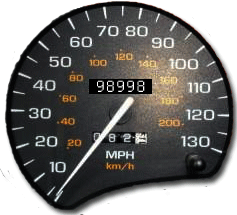




|
Detecting Odometer Fraud
It can be very difficult to detect odometer tampering, but it is not impossible. How do you know if your odometer has been tampered with?
Read the following tips if you are considering buying a used car or have recently purchased one.
- Ask to see the title. Compare the mileage on it with the vehicle's odometer. Be sure to examine the title closely if the mileage seems obscured or is not easy to read.
Look at the date the title was issued. Be suspicious if the vehicle is being sold shortly after the title was issued. A new title could have been issued simply to hide a mileage alteration.
- Compare the mileage on the odometer with the mileage indicated on the vehicle's maintenance or inspection records.
Also, look for oil-change and maintenance stickers on windows or door frames, in the glove box or under the hood that are inconsistent with the mileage on the odometer.
If the air conditioning system has been serviced, there should be a record with date and mileage wrapped around some of the A/C lines.
- Check that the numbers on the odometer gauge are aligned correctly. They shouldn't be crooked, contain gaps or jiggle when you bang on the dash with your hand.
If the vehicle has an analog odometer, as opposed to newer digital readouts, check that the numbers are lined up straight. Pay special attention to the 10,000 digit.
- Examine the tires. If the odometer on your car shows 20,000 or less, it should have the original tires. New tires that are mismatched by brand, size, or type.
- Look at the wear and tear on the vehicle; especially the gas, brake and clutch pedals, door strikers, and floor mats to be sure it seems consistent with and appropriate for the number of miles displayed on the odometer.
- Request a carfax Vehicle History Report to check for odometer discrepancies in the vehicle's history. If the seller doesn't have a vehicle history report, use the car's VIN to order a CARFAX vehicle history report online.
- Dash screws loose or missing
- Scratches in odometer area
- Excessive wear in the interior, particularly in the driver's area
- Vehicle registration inconsistent with either mismatched vehicle identification numbers (VIN) and/or odometer readings
- Parts that are replaced that would not normally need to be replaced on a low-mileage vehicle such as hoses, clamps, fan and air-conditioning belts, batteries, etc.
- Test-drive the vehicle. When test driving the car, notice if the speedometer sticks.
- Check the owner's manual to see if there is a maintenance record there. Or see if pages that may have contained a maintenance record have been removed.
- Inspect the vehicle. Have a mechanic of your choosing inspect the vehicle. As part of that inspection, he should look for signs of tampering.
Questions? Please contact us by filling our online application.
|
| © Copyright 2006-2025 Kimmel & Silverman, P.C., All Rights Reserved. Disclaimer | Home |
